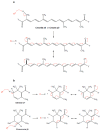Saffron (Crocus sativus L.): A Source of Nutrients for Health and for the Treatment of Neuropsychiatric and Age-Related Diseases
- PMID: 35276955
- PMCID: PMC8839854
- DOI: 10.3390/nu14030597
Saffron (Crocus sativus L.): A Source of Nutrients for Health and for the Treatment of Neuropsychiatric and Age-Related Diseases
Abstract
Saffron (Crocus sativus L.) is a medicinal plant, originally cultivated in the East and Middle East, and later in some Mediterranean countries. Saffron is obtained from the stigmas of the plant. Currently, the use of saffron is undergoing a revival. The medicinal virtues of saffron, its culinary use and its high added value have led to the clarification of its phytochemical profile and its biological and therapeutic characteristics. Saffron is rich in carotenoids and terpenes. The major products of saffron are crocins and crocetin (carotenoids) deriving from zeaxanthin, pirocrocin and safranal, which give it its taste and aroma, respectively. Saffron and its major compounds have powerful antioxidant and anti-inflammatory properties in vitro and in vivo. Anti-tumor properties have also been described. The goal of this review is to present the beneficial effects of saffron and its main constituent molecules on neuropsychiatric diseases (depression, anxiety and schizophrenia) as well as on the most frequent age-related diseases (cardiovascular, ocular and neurodegenerative diseases, as well as sarcopenia). Overall, the phytochemical profile of saffron confers many beneficial virtues on human health and, in particular, on the prevention of age-related diseases, which is a major asset reinforcing the interest for this medicinal plant.
Keywords: age-related diseases; crocetin; crocins; crocus sativus; neuropsychiatric diseases; nutrients; picrocrocin; saffron; safranal.
Conflict of interest statement
The authors declare no conflict of interest.
Figures






References
-
- Palomares C. Le Safran, Précieuse Épice Ou Précieux Médicament? [(accessed on 6 January 2022)]. Available online: https://hal.univ-lorraine.fr/hal-01732922/document.
-
- Dubois A. Analyse de la Filière Safran du MAROC: Quelles Perspectives Pour la Mise en Place D’Une Indication Géographique? [(accessed on 6 January 2022)]. Available online: http://bionaturehouse.com/files/StudieSafranMarokkoCIHEAM.pdf.
-
- Aucante P. In: Le Safran. Sud A., editor. Actes Sud; Arles, France: 2000.
-
- Crozet A., de Sus-Rousset H., de Durfort S.J. Crocus sativus L. (Iridaceae), le safran (I) Phytothérapie. 2012;10:121–125. doi: 10.1007/s10298-012-0696-z. - DOI
-
- [(accessed on 6 January 2022)]. Available online: https://www.fao.org/fileadmin/templates/olq/documents/documents/morocco/....
Publication types
MeSH terms
Substances
LinkOut - more resources
Full Text Sources

